Word stress in English Nature of word

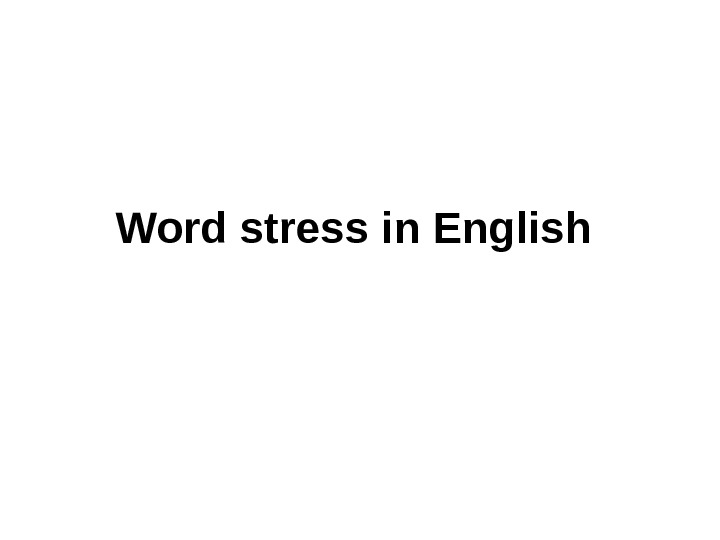

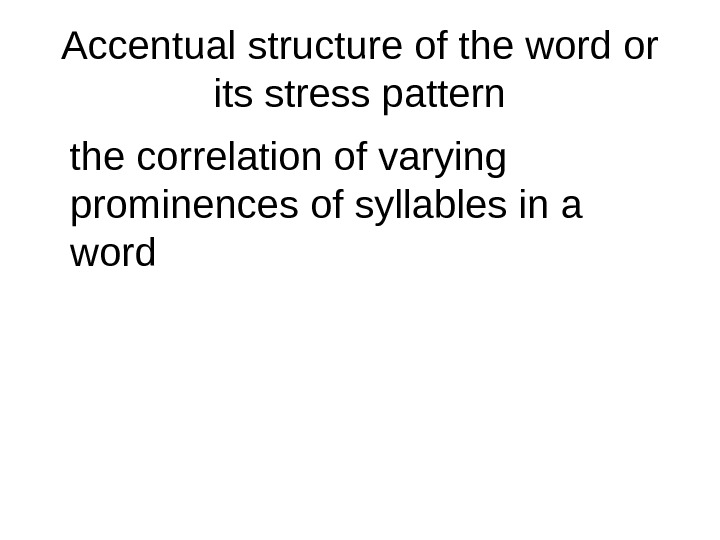


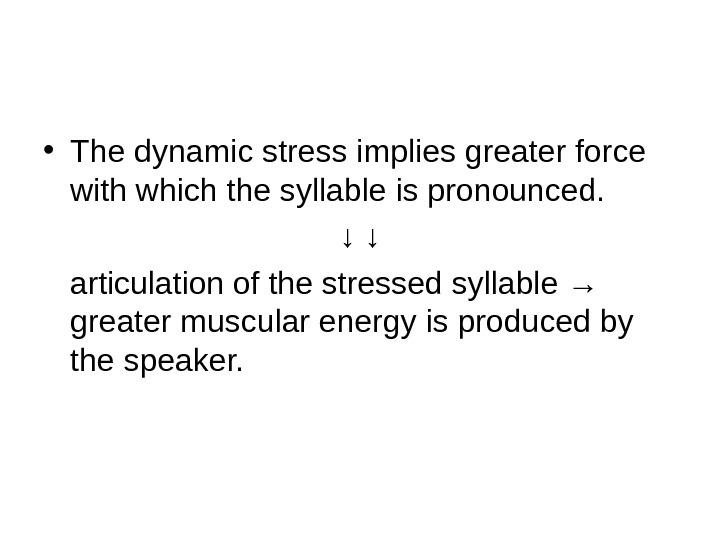
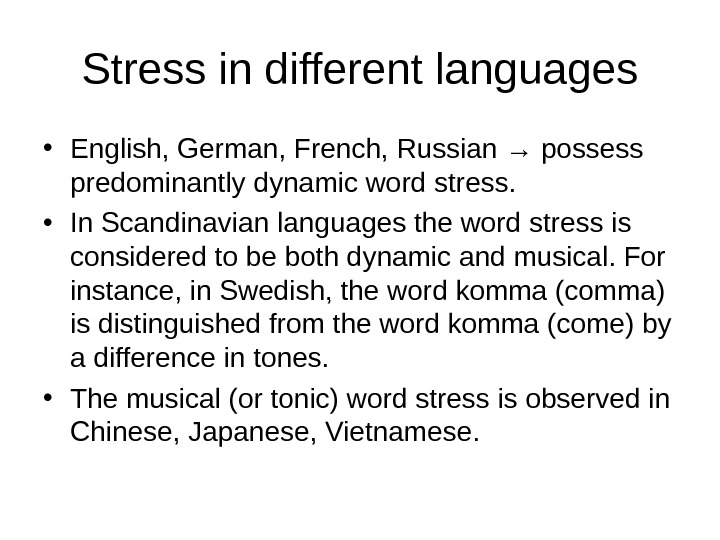

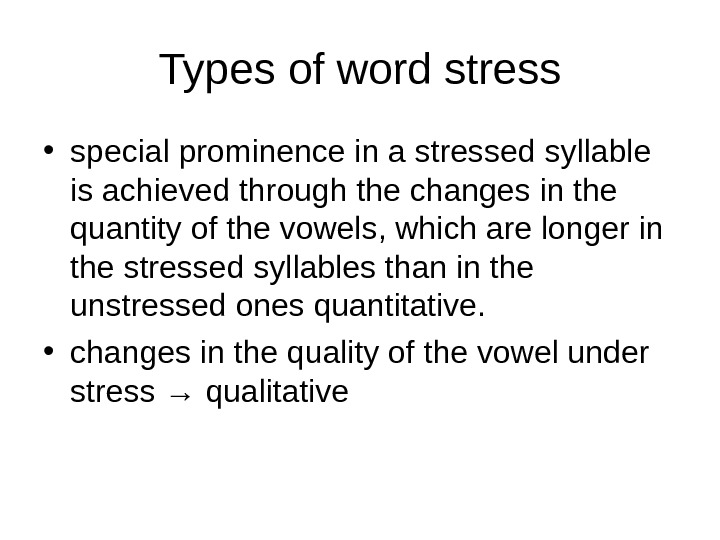

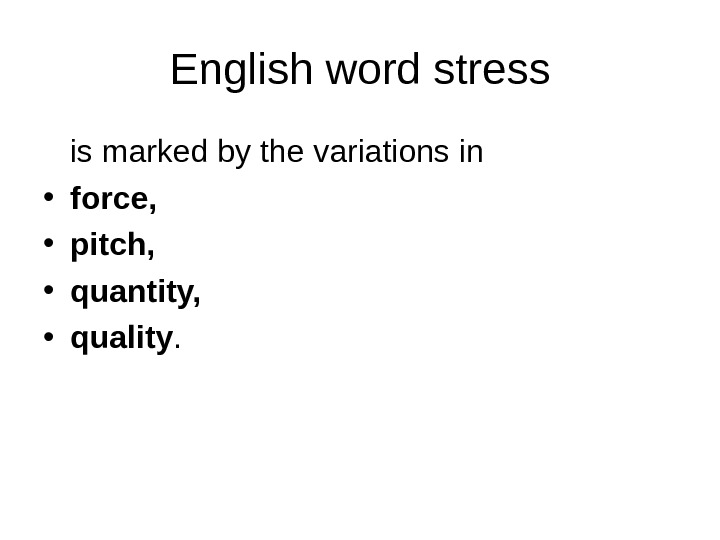
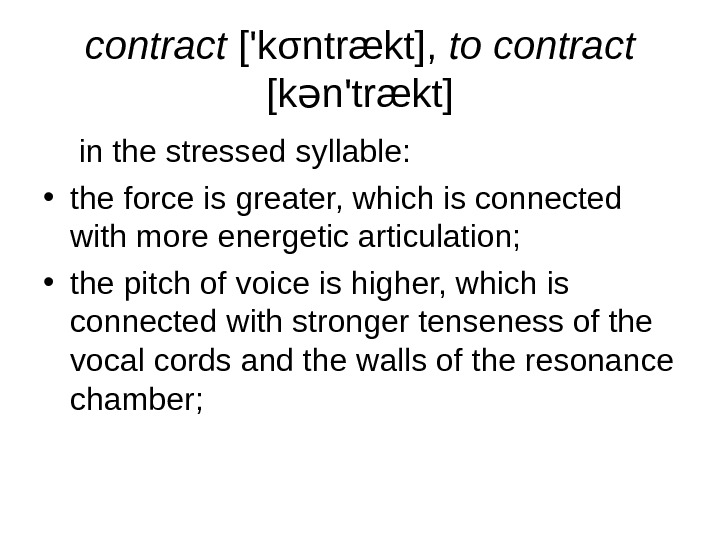
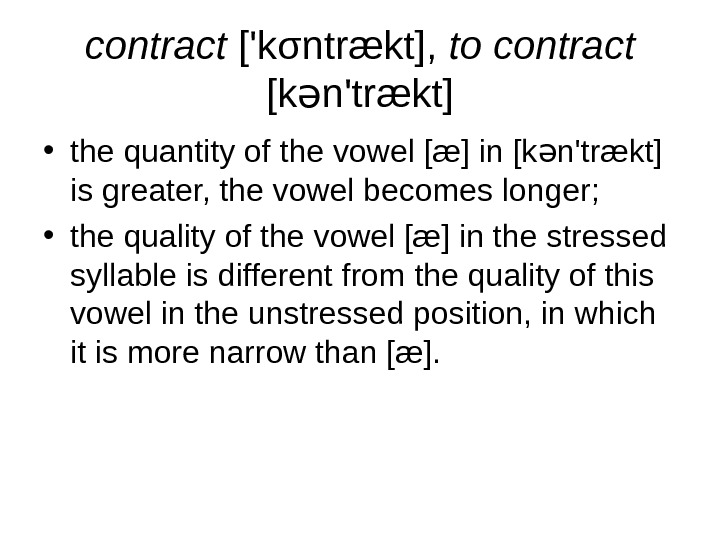
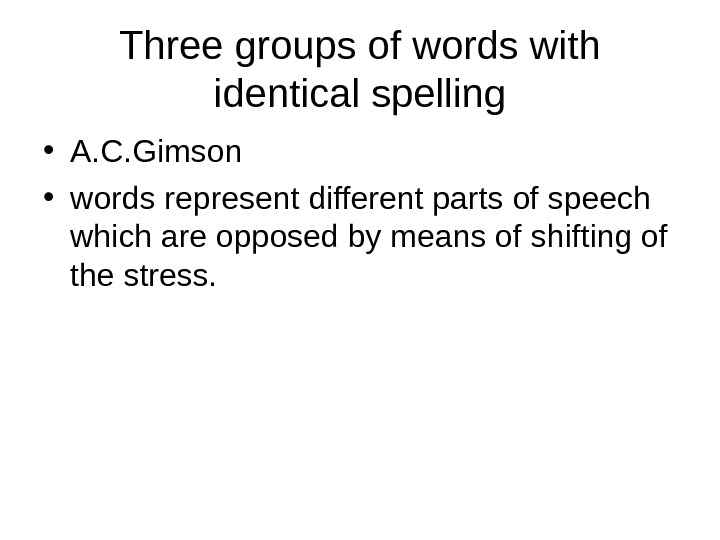
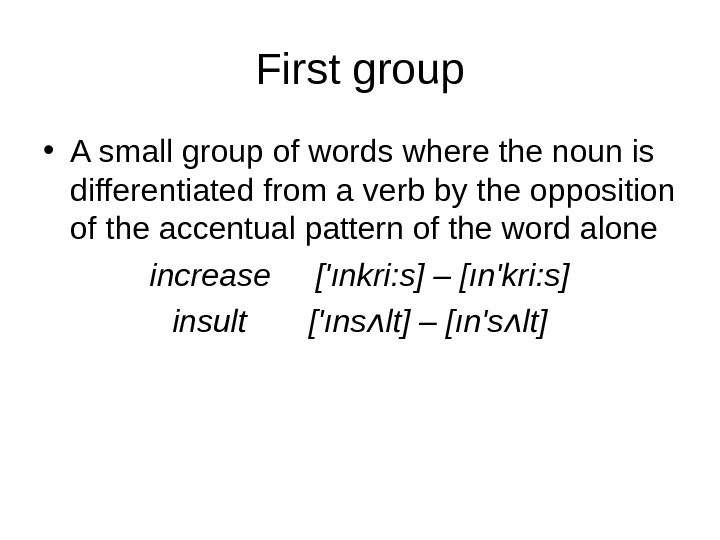
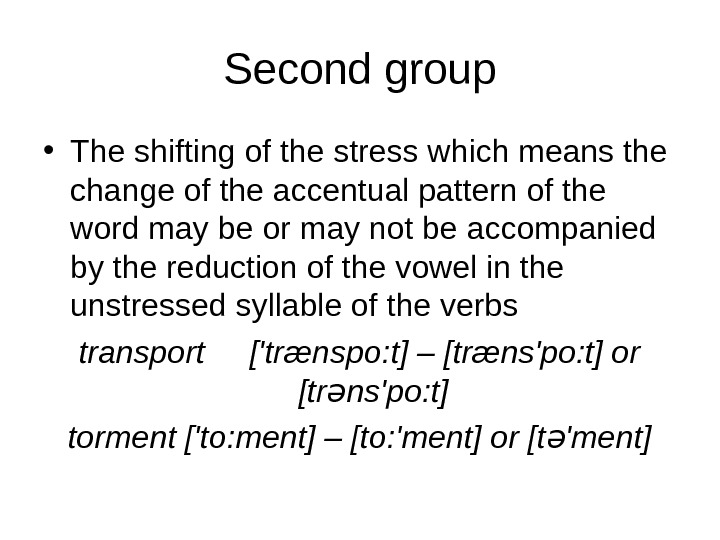
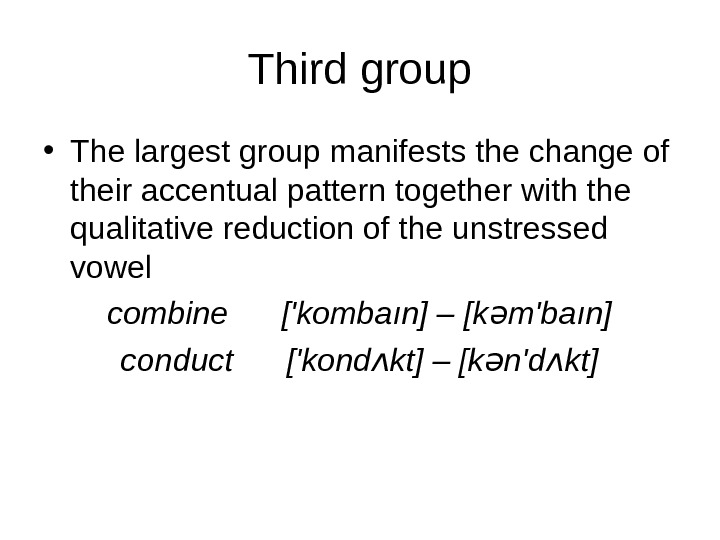
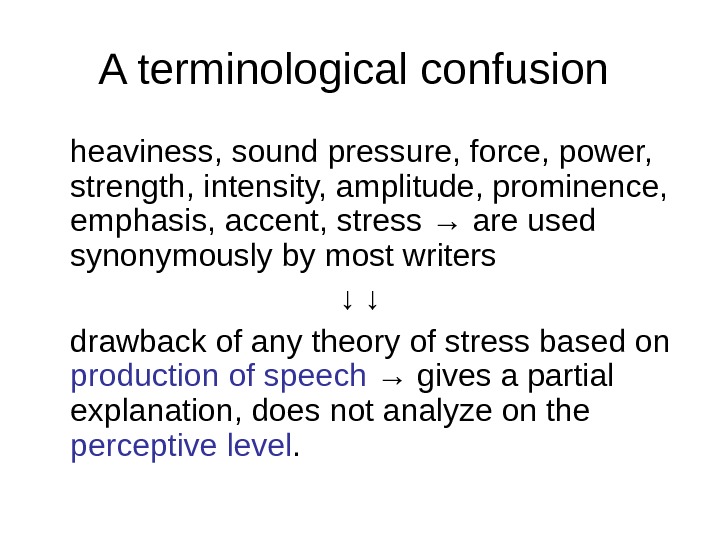
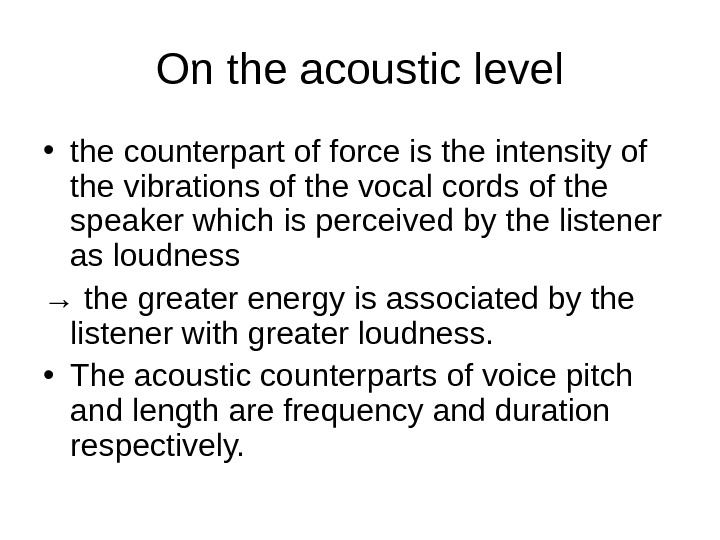


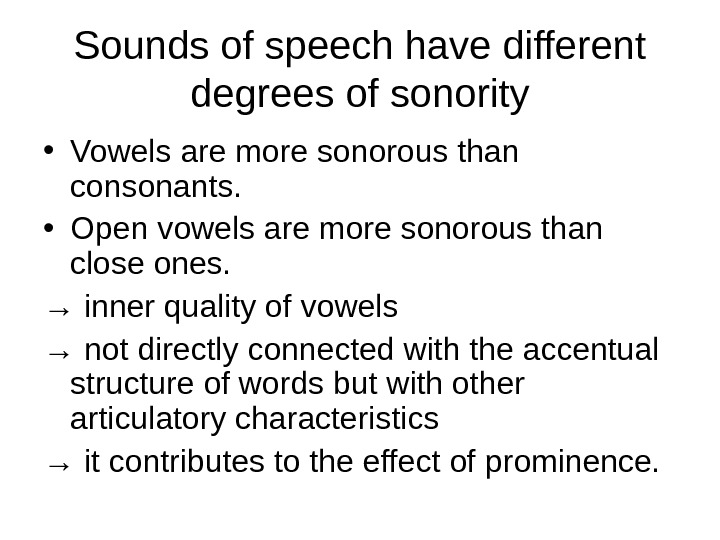
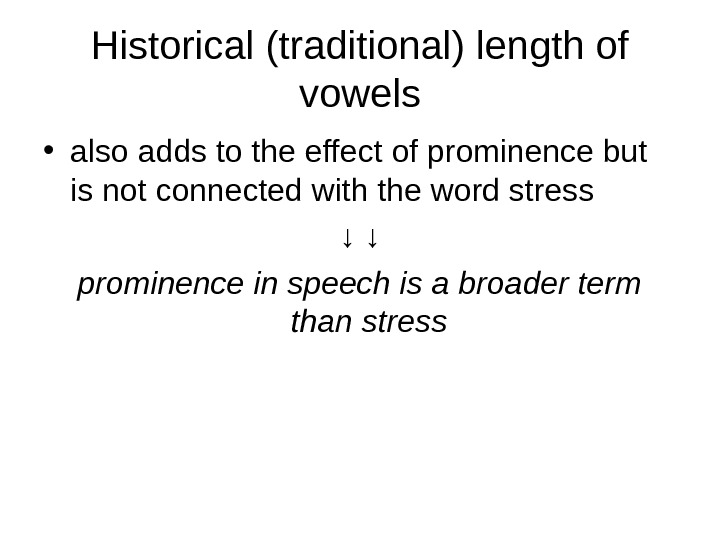


- Размер: 52.5 Кб
- Количество слайдов: 25
Описание презентации Word stress in English Nature of word по слайдам
 Word stress in English
Word stress in English
 Nature of word stress • The sequence of syllables in the word is not pronounced identically. • The syllable or syllables which are uttered with more prominence than the other syllables of the word are said to be stressed or accented.
Nature of word stress • The sequence of syllables in the word is not pronounced identically. • The syllable or syllables which are uttered with more prominence than the other syllables of the word are said to be stressed or accented.
 Accentual structure of the word or its stress pattern the correlation of varying prominences of syllables in a word
Accentual structure of the word or its stress pattern the correlation of varying prominences of syllables in a word
 Definition of stress is different by different authors: • an increase of energy, accompanied by an increase of expiratory and articulatory activity (B. A. Bogoroditsky). • the degree of force, which is accompanied by a strong force of exhalation and gives an impression of loudness (D. Jones).
Definition of stress is different by different authors: • an increase of energy, accompanied by an increase of expiratory and articulatory activity (B. A. Bogoroditsky). • the degree of force, which is accompanied by a strong force of exhalation and gives an impression of loudness (D. Jones).
 Definition of stress • stress is connected with the force of breath (H. Sweet). • the effect of prominence is achieved by any or all of four factors: force, tone, length and vowel colour (A. C. Gimson).
Definition of stress • stress is connected with the force of breath (H. Sweet). • the effect of prominence is achieved by any or all of four factors: force, tone, length and vowel colour (A. C. Gimson).
 • The dynamic stress implies greater force with which the syllable is pronounced. ↓ ↓ articulation of the stressed syllable → greater muscular energy is produced by the speaker.
• The dynamic stress implies greater force with which the syllable is pronounced. ↓ ↓ articulation of the stressed syllable → greater muscular energy is produced by the speaker.
 Stress in different languages • English, German, French, Russian → possess predominantly dynamic word stress. • In Scandinavian languages the word stress is considered to be both dynamic and musical. For instance, in Swedish, the word komma (comma) is distinguished from the word komma (come) by a difference in tones. • The musical (or tonic) word stress is observed in Chinese, Japanese, Vietnamese.
Stress in different languages • English, German, French, Russian → possess predominantly dynamic word stress. • In Scandinavian languages the word stress is considered to be both dynamic and musical. For instance, in Swedish, the word komma (comma) is distinguished from the word komma (come) by a difference in tones. • The musical (or tonic) word stress is observed in Chinese, Japanese, Vietnamese.
 Types of word stress • special prominence in a stressed syllable is achieved mainly through the intensity of articulation → dynamic, or force stress. • special prominence in a stressed syllable is achieved mainly through the change of pitch, or musical tone → musical, or tonic.
Types of word stress • special prominence in a stressed syllable is achieved mainly through the intensity of articulation → dynamic, or force stress. • special prominence in a stressed syllable is achieved mainly through the change of pitch, or musical tone → musical, or tonic.
 Types of word stress • special prominence in a stressed syllable is achieved through the changes in the quantity of the vowels, which are longer in the stressed syllables than in the unstressed ones quantitative. • changes in the quality of the vowel under stress → qualitative
Types of word stress • special prominence in a stressed syllable is achieved through the changes in the quantity of the vowels, which are longer in the stressed syllables than in the unstressed ones quantitative. • changes in the quality of the vowel under stress → qualitative
 English word stress or accent is a complex phenomenon • traditionally defined as dynamic, but the special prominence of the stressed syllables is manifested also through the changes in the vowel quantity, consonant and vowel quality and pitch of the voice. ↓ ↓
English word stress or accent is a complex phenomenon • traditionally defined as dynamic, but the special prominence of the stressed syllables is manifested also through the changes in the vowel quantity, consonant and vowel quality and pitch of the voice. ↓ ↓
 English word stress is marked by the variations in • force, • pitch, • quantity, • quality.
English word stress is marked by the variations in • force, • pitch, • quantity, • quality.
![contract ['kσntrækt], to contract [k n'trækt]ə in the stressed syllable: • the contract ['kσntrækt], to contract [k n'trækt]ə in the stressed syllable: • the](/docs//12_word_stress_in_english_images/12_word_stress_in_english_11.jpg) contract [‘kσntrækt], to contract [k n’trækt]ə in the stressed syllable: • the force is greater, which is connected with more energetic articulation; • the pitch of voice is higher, which is connected with stronger tenseness of the vocal cords and the walls of the resonance chamber;
contract [‘kσntrækt], to contract [k n’trækt]ə in the stressed syllable: • the force is greater, which is connected with more energetic articulation; • the pitch of voice is higher, which is connected with stronger tenseness of the vocal cords and the walls of the resonance chamber;
![contract ['kσntrækt], to contract [k n'trækt]ə • the quantity of the vowel [æ] contract ['kσntrækt], to contract [k n'trækt]ə • the quantity of the vowel [æ]](/docs//12_word_stress_in_english_images/12_word_stress_in_english_12.jpg) contract [‘kσntrækt], to contract [k n’trækt]ə • the quantity of the vowel [æ] in [k n’trækt] ə is greater, the vowel becomes longer; • the quality of the vowel [æ] in the stressed syllable is different from the quality of this vowel in the unstressed position, in which it is more narrow than [æ].
contract [‘kσntrækt], to contract [k n’trækt]ə • the quantity of the vowel [æ] in [k n’trækt] ə is greater, the vowel becomes longer; • the quality of the vowel [æ] in the stressed syllable is different from the quality of this vowel in the unstressed position, in which it is more narrow than [æ].
 Three groups of words with identical spelling • A. C. Gimson • words represent different parts of speech which are opposed by means of shifting of the stress.
Three groups of words with identical spelling • A. C. Gimson • words represent different parts of speech which are opposed by means of shifting of the stress.
 First group • A small group of words where the noun is differentiated from a verb by the opposition of the accentual pattern of the word alone increase [‘ınkri: s] – [ın’kri: s] insult [‘ıns lt] – [ın’s lt]ʌ ʌ
First group • A small group of words where the noun is differentiated from a verb by the opposition of the accentual pattern of the word alone increase [‘ınkri: s] – [ın’kri: s] insult [‘ıns lt] – [ın’s lt]ʌ ʌ
 Second group • The shifting of the stress which means the change of the accentual pattern of the word may be or may not be accompanied by the reduction of the vowel in the unstressed syllable of the verbs transport [‘trænspo: t] – [træns’po: t] or [tr ns’po: t]ǝ torment [‘to: ment] – [to: ‘ment] or [t ‘ment] ǝ
Second group • The shifting of the stress which means the change of the accentual pattern of the word may be or may not be accompanied by the reduction of the vowel in the unstressed syllable of the verbs transport [‘trænspo: t] – [træns’po: t] or [tr ns’po: t]ǝ torment [‘to: ment] – [to: ‘ment] or [t ‘ment] ǝ
 Third group • The largest group manifests the change of their accentual pattern together with the qualitative reduction of the unstressed vowel combine [‘kombaın] – [k m’baın]ǝ conduct [‘kond kt] – [k n’d kt] ʌ ǝ ʌ
Third group • The largest group manifests the change of their accentual pattern together with the qualitative reduction of the unstressed vowel combine [‘kombaın] – [k m’baın]ǝ conduct [‘kond kt] – [k n’d kt] ʌ ǝ ʌ
 A terminological confusion heaviness, sound pressure, force, power, strength, intensity, amplitude, prominence, emphasis, accent, stress → are used synonymously by most writers ↓ ↓ drawback of any theory of stress based on production of speech → gives a partial explanation, does not analyze on the perceptive level.
A terminological confusion heaviness, sound pressure, force, power, strength, intensity, amplitude, prominence, emphasis, accent, stress → are used synonymously by most writers ↓ ↓ drawback of any theory of stress based on production of speech → gives a partial explanation, does not analyze on the perceptive level.
 On the acoustic level • the counterpart of force is the intensity of the vibrations of the vocal cords of the speaker which is perceived by the listener as loudness → the greater energy is associated by the listener with greater loudness. • The acoustic counterparts of voice pitch and length are frequency and duration respectively.
On the acoustic level • the counterpart of force is the intensity of the vibrations of the vocal cords of the speaker which is perceived by the listener as loudness → the greater energy is associated by the listener with greater loudness. • The acoustic counterparts of voice pitch and length are frequency and duration respectively.
 Russian accentual structure English accentual structure ● quantitative component plays a greater role ● the quantitative component of word stress is not of primary importance ● vowels of full formation and full length in unstressed positions are never pronounced, they are always reduced ↓ ↓ the vowels of full length are unmistakably perceived as stressed ● the nonreduced vowels in the unstressed syllables sometimes occur in English words, e. g. ‘architect, ‘transport
Russian accentual structure English accentual structure ● quantitative component plays a greater role ● the quantitative component of word stress is not of primary importance ● vowels of full formation and full length in unstressed positions are never pronounced, they are always reduced ↓ ↓ the vowels of full length are unmistakably perceived as stressed ● the nonreduced vowels in the unstressed syllables sometimes occur in English words, e. g. ‘architect, ‘transport
 The stressed syllables → the most prominent syllables • the notions «stressed» and «prominent» should not be used synonymically (G. P. Torsuev) • The effect of prominence is created by some phonetic features of sounds which have nothing to do with word or sentence stress.
The stressed syllables → the most prominent syllables • the notions «stressed» and «prominent» should not be used synonymically (G. P. Torsuev) • The effect of prominence is created by some phonetic features of sounds which have nothing to do with word or sentence stress.
 Sounds of speech have different degrees of sonority • Vowels are more sonorous than consonants. • Open vowels are more sonorous than close ones. → inner quality of vowels → not directly connected with the accentual structure of words but with other articulatory characteristics → it contributes to the effect of prominence.
Sounds of speech have different degrees of sonority • Vowels are more sonorous than consonants. • Open vowels are more sonorous than close ones. → inner quality of vowels → not directly connected with the accentual structure of words but with other articulatory characteristics → it contributes to the effect of prominence.
 Historical (traditional) length of vowels • also adds to the effect of prominence but is not connected with the word stress ↓ ↓ prominence in speech is a broader term than stress
Historical (traditional) length of vowels • also adds to the effect of prominence but is not connected with the word stress ↓ ↓ prominence in speech is a broader term than stress
 Stress difficulties peculiar to the accentual structure • are connected with the vowel special and inherent prominence. • In identical positions the intensity of English vowels is different. • The highest in intensity is [a: ], then go [ о : , з : , i: , u: , æ, σ, e, υ , ı].
Stress difficulties peculiar to the accentual structure • are connected with the vowel special and inherent prominence. • In identical positions the intensity of English vowels is different. • The highest in intensity is [a: ], then go [ о : , з : , i: , u: , æ, σ, e, υ , ı].
![Peculiarities of sounds in accented syllables • [ ] is never stressedə • Peculiarities of sounds in accented syllables • [ ] is never stressedə •](/docs//12_word_stress_in_english_images/12_word_stress_in_english_24.jpg) Peculiarities of sounds in accented syllables • [ ] is never stressedə • [i, e, υ ] tend to occur in unstressed syllables • Syllables with the syllabic [l, m, n] are never stressed • Unstressed diphthongs may partially lose their glide quality. • In stressed syllables English stops have complete closure, fricatives have full friction, and features of fortis/lenis distinction are clearly defined.
Peculiarities of sounds in accented syllables • [ ] is never stressedə • [i, e, υ ] tend to occur in unstressed syllables • Syllables with the syllabic [l, m, n] are never stressed • Unstressed diphthongs may partially lose their glide quality. • In stressed syllables English stops have complete closure, fricatives have full friction, and features of fortis/lenis distinction are clearly defined.

